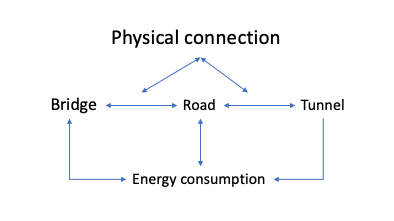For this project traffic infrastructure has been researched. The civil systems individually chosen by the group members were two steel bridges and two subsea tunnels.
Traffic infrastructure consists of complex civil systems designed for a long lifetime. Tunnels and bridges compose important supporting systems within traffic infrastructure, which improve accessibility and transportation efficiency. These are however components that are subject to degradation due to both outer and inner factors. Among outer factors traffic loads must be addressed. Inner factors account for such as the main construction materials, which for the chosen systems are concrete and steel.
The chosen civil systems are naturally connected within traffic infrastructure. For the integration, the systems are considered as parts of a roadway. The systems are considered to be physically connected, and the connection is illustrated below. This simplifies the integration, as the outer factors leading to degradation that are related to traffic can be considered equal for the systems. The combined system considered is a tunnel followed by a bridge. The tunnel length is set to 1000 m, whereas the bridge length is set to 300 m.
These simplifications leave the following challenges for the integration:
- Alignment of maintenance strategies for the different systems
- Distribution of loads
Tunnels and bridges represent alternative ways for cross strait transportation. Both systems can often be found in the same traffic network. As the subsea tunnel is immersed underwater whereas the bridge is on ground level or even elevated, a certain gradient in the interface between the systems is required. From previous research it is known that a steeper gradient is more prone to accidents, e.g. from fires in heavy vehicles. Further, the overall outer wear on the systems is highly dependent on the traffic loads. For example the speed limit throughout the tunnel will typically be lower than on adjoining roads, implying a reduced wear on the deck due to traffic.
Since the main construction materials are similar, it is possible to coordinate necessary interventions. In specific cases such an approach can be favorable, but on a general basis as illustrated below, it is found better to consider the systems separate to prevent longer operational down-times.

